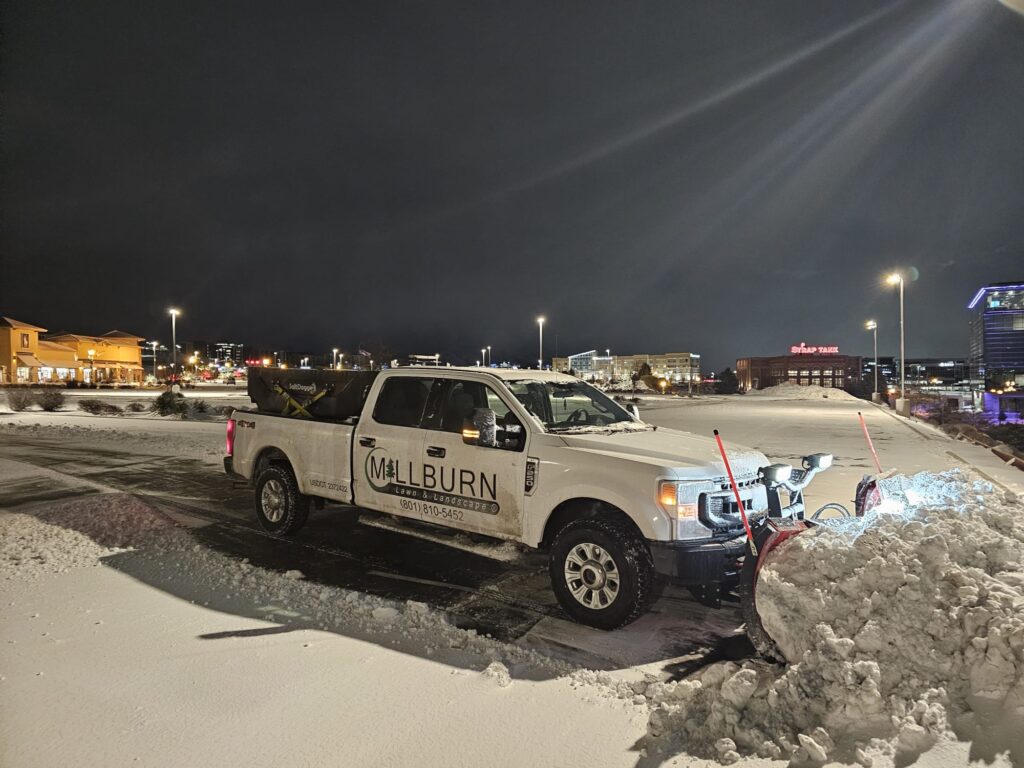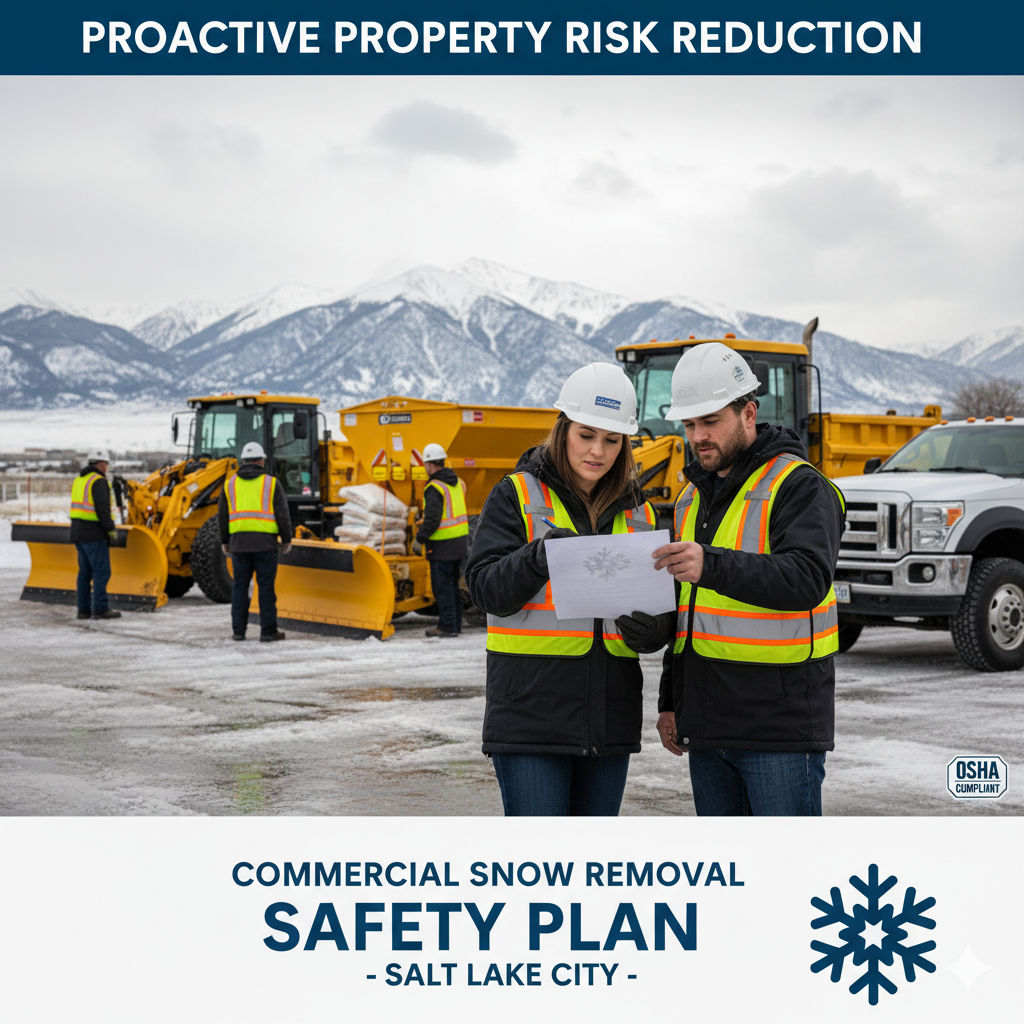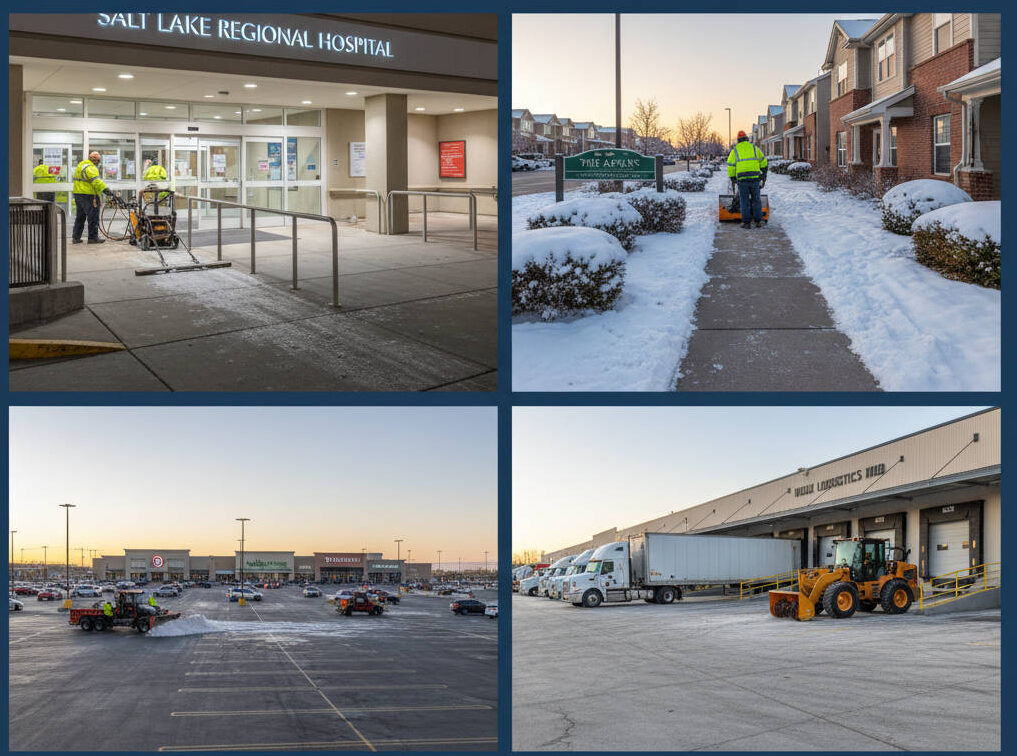Why Safety Plans Matter for Commercial Snow Removal in Salt Lake City
In Salt Lake City, winter storms can hit fast—and when they do, businesses and property managers must be ready. A few inches of snow can quickly turn into a safety hazard, leading to slip-and-fall injuries, property damage, and costly downtime.
That’s why every professional commercial snow removal service in Salt Lake City should operate under a detailed, documented snow removal safety plan.
These plans go far beyond just plowing and salting—they outline how your contractor will protect tenants, employees, and customers throughout the winter season. The best snow management teams integrate OSHA winter safety standards, equipment maintenance schedules, de-icing protocols, and emergency communication systems into their operations.
If your contractor can’t provide a safety plan, your business is exposed to both risk and liability.
The Foundation of a Snow Removal Safety Plan
A snow removal safety plan is a written framework that defines how a contractor will keep your property safe, accessible, and compliant throughout winter operations. For Salt Lake City property managers, this plan acts as both a liability shield and a management tool.
The core components of a professional plan include:
- Pre-Season Site Inspections and Mapping
Before the first snowflake falls, your contractor should inspect your property, noting curbs, drains, fire hydrants, loading docks, entrances, and high-traffic pedestrian areas. This ensures plow operators know every corner of the site—even when it’s buried in snow. - Defined Service Triggers and Response Times
Clear thresholds should be set for when snow removal begins—typically after one inch of accumulation. Timely response is crucial to preventing ice buildup and ensuring compliance with local safety ordinances. - De-Icing and Anti-Icing Protocols
The plan should specify approved de-icing materials, application rates, and environmentally responsible practices. Professional contractors in Utah often use liquid brine pre-treatments to prevent ice bonding, reducing salt usage and environmental impact. - Equipment Maintenance and Operator Safety Training
Contractors must include schedules for vehicle inspections, blade checks, and tire replacements. Operators should undergo annual OSHA winter safety training, including defensive driving and equipment operation on icy surfaces. - Documentation and Communication Systems
A credible snow management team provides time-stamped service reports, site photos, and GPS tracking for verification. These records protect both the property owner and contractor in the event of an incident.
Why Property Managers Should Demand Written Safety Documentation
Verbal agreements aren’t enough when dealing with safety-critical services. Property managers should insist on written safety documentation before signing any snow removal contract.
This documentation should include:
- A full safety policy statement signed by management.
- Proof of compliance with OSHA standards and Utah Department of Transportation (UDOT) vehicle regulations.
- Copies of insurance certificates (general liability, workers’ compensation, and vehicle coverage).
- Employee training certifications for snow removal operations.
- A record-keeping system for incidents, accidents, and near misses.
Written policies prove due diligence—a critical defense if a liability claim arises from an accident on your property.
Contractor Compliance: The Utah Standard
Property managers in Utah must ensure contractor compliance with local laws and industry standards. Reliable commercial snow removal services in Salt Lake City follow guidelines that protect both the client and the contractor.
Key compliance factors include:
- Licensing and Insurance: Your snow removal company should carry appropriate licensing and at least $1 million in liability insurance coverage.
- Driver Certification: All plow and loader operators should hold valid certifications or verifiable training records.
- Environmental Compliance: Utah regulations restrict excessive salt runoff; contractors should follow best practices to protect local water systems.
- Documentation for Safety Audits: Contractors should be able to produce records for audits, inspections, and safety investigations at any time.
Choosing a contractor who prioritizes compliance in Utah ensures your business stays legally and environmentally protected throughout the winter.
Risk Reduction: The True Value of a Snow Removal Safety Plan
Effective safety planning is more than just regulatory compliance—it’s about property risk reduction.
Here’s how a well-designed safety plan protects commercial properties:
1. Prevents Slip-and-Fall Accidents
By proactively managing sidewalks, entrances, and parking lots, contractors prevent hazardous conditions that cause most winter-related injuries.
2. Minimizes Property Damage
Accurate site mapping prevents plows from damaging curbs, landscaping, or signage. Well-maintained equipment reduces scraping and asphalt wear.
3. Ensures Operational Continuity
With predefined response times and backup crews, businesses remain accessible—even during heavy storms. This reliability keeps employees and customers safe while protecting revenue.
4. Supports Legal Defense in Case of Claims
Time-stamped service logs and GPS data serve as crucial evidence if a customer alleges negligence. These records show that the property was properly maintained.
OSHA Winter Safety and Employee Training
The Occupational Safety and Health Administration (OSHA) enforces strict safety protocols for winter operations, especially when heavy equipment and ice hazards are involved. Property managers should confirm that contractors follow OSHA’s “Winter Weather Preparedness” guidelines.
Essential OSHA winter safety elements include:
- Employee education on cold stress prevention and frostbite awareness.
- Proper use of personal protective equipment (PPE)—like reflective gear, gloves, and insulated footwear.
- Equipment lockout/tagout procedures for maintenance safety.
- Safe handling and storage of de-icing chemicals.
- Continuous monitoring of working conditions, particularly during blizzards or freezing rain events.
A contractor who prioritizes OSHA compliance demonstrates commitment to employee well-being and client protection alike.
Communication: The Cornerstone of Safety
In modern snow management, communication technology separates amateurs from professionals. Leading commercial snow removal services in Salt Lake City use cloud-based reporting systems and live dispatch platforms to keep clients informed in real time.
Your contractor should offer:
- Real-time service notifications (text or email).
- GPS-tracked vehicles for accountability.
- Photo verification after each service.
- Dedicated emergency contacts available 24/7.
These systems not only improve transparency but also streamline response times—ensuring the right equipment reaches your site quickly when snow starts falling.
Contractor Accountability: Red Flags to Watch For
Even in Salt Lake City’s competitive snow removal market, not all contractors operate with equal diligence. Property managers should be cautious of red flags such as:
- Vague contracts with no written safety policies.
- No proof of insurance or outdated documentation.
- Overreliance on subcontractors without background checks.
- Lack of response tracking or service logs.
- Poor communication during previous snow events.
Demanding clear safety and compliance protocols from the start helps eliminate unreliable vendors and ensures smoother operations throughout the winter.
Pre-Season Planning: Setting Expectations Early
The best snow removal safety plans start before the first storm hits. Property managers should meet with contractors in the fall to outline expectations, service triggers, and site-specific risks.
Pre-season planning should include:
- Property walk-throughs with managers and equipment operators.
- Stake and marker placement around curbs, fire hydrants, and sensitive areas.
- Priority maps identifying high-traffic zones and emergency access routes.
- Review of snow storage areas to prevent property or landscaping damage.
By planning early, both parties can avoid confusion and costly mistakes during the peak winter months.

Protect your property, employees, and customers this winter.
Partner with a team that takes safety as seriously as you do. Millburn Landscape provides comprehensive commercial snow removal services in Salt Lake City, complete with customized snow removal safety plans, OSHA-compliant training, and detailed documentation for full peace of mind.
Call (801) 810-5452 today or visit Millburn Landscape to schedule your pre-season consultation and secure your snow removal contract before the next storm hits.
Frequently Asked Questions
Q: What should a snow removal safety plan include?
A: It should cover pre-season inspections, service triggers, de-icing procedures, equipment maintenance, OSHA training, and reporting protocols.
Q: Why is OSHA winter safety important for contractors?
A: OSHA safety standards prevent workplace injuries, ensure proper use of equipment, and verify that employees operate safely under extreme weather conditions.
Q: How can I verify contractor compliance in Utah?
A: Ask for licensing proof, insurance certificates, and employee training records. Contractors should also follow environmental salt application standards set by Utah agencies.
Q: How do snow removal safety plans reduce property risk?
A: They prevent accidents, ensure timely response, and provide legal documentation that protects property owners from liability claims.
Q: When should I start planning for snow removal?
A: Begin in early fall—before temperatures drop—so contractors can inspect your property, place markers, and create a customized service strategy.



